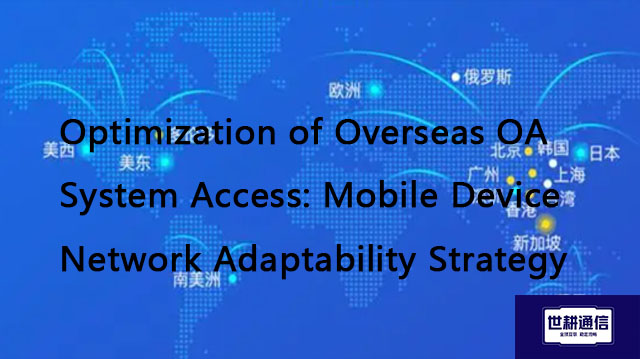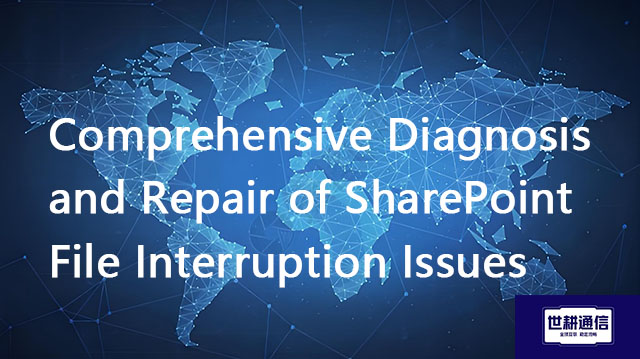Optimization of Overseas OA System Access: Mobile Device Network Adaptability Strategy??? Solution//Global IPLC service provider of Shigeng Communication
一、With the popularization of globalized office models, overseas employees accessing OA systems through mobile devices has become the norm. However, issues such as cross-border network latency, unstable connections, and high packet loss rates severely limit the access experience and work efficiency. A survey conducted on multinational corporations showed that over 65% of overseas employees reported significant lag when accessing OA on mobile devices, with an average page loading time of over 6 seconds, far exceeding the user's acceptable threshold of 300ms.
1. The core challenge of overseas mobile access OA
Network transmission bottleneck:
High latency: Physical distance leads to a significant increase in round-trip time (RTT) of data packets (e.g. up to 200ms+between China and the United States).
Bandwidth fluctuations: Overseas local networks (especially 4G/5G) have unstable bandwidth and uneven quality of public Wi Fi.
High packet loss rate: International link congestion or regional network issues result in critical data loss, triggering retransmission.
Protocol and transmission efficiency:
Limitations of TCP: Traditional TCP is inefficient in long-distance high latency networks, with queue head blocking and slow start exacerbating latency.
Request bloating: Unoptimized front-end resources (images, JS, CSS) significantly increase loading time, exacerbating HTTP/1. x concurrency restrictions.
Diversity of terminal devices:
Performance differences: Mid to low end mobile phones have limited processing power and memory, and slow rendering of complex pages.
Screen adaptation: Poor responsive design leads to layout disorder and difficulty in operation.
Offline scenario: When the network is interrupted, critical operations such as approval and document viewing cannot be performed.
2. Adaptive optimization strategy for mobile device networks
Network layer optimization: building high-speed transmission channels
QUIC protocol replaces TCP: implements 0-RTT/1-RTT fast connections based on UDP, with built-in multiplexing to solve queue head blocking, and TLS 1.3 encryption is more efficient (Google tested that QUIC reduces latency by more than 30% compared to TCP).
HTTP/2 or HTTP/3: Supports header compression, multiplexing, and server-side push to improve resource loading efficiency.
SD-WAN intelligent routing: Real time monitoring of link quality, dynamically selecting the optimal path to bypass congested nodes, reducing latency and packet loss (measured cross-border access latency reduced by 30% -60%).
Distributed access points: Deploy access points (PoPs) in key overseas areas, allowing users to access nearby and significantly shorten the last mile.
Deploying a global acceleration network:
Protocol optimization and upgrade:
Transport layer optimization: slimming and intelligent scheduling
GraphQL/BFF layer: Get data on demand to avoid excessive transmission.
Request merging and batch processing: reduce connection establishment overhead.
Network quality perception: The client monitors network bandwidth and latency in real-time (such as through the Navigator. connection API).
Intelligent content adaptation: Automatically switch low resolution images in weak network environments, simplify UI components, and reduce unnecessary data requests.
Ultimate resource compression: images (WebP/AVIF format), JS/CSS (Minify+Tree Shaking+Gzip/Brotli compression).
On demand loading and lazy loading: Delayed loading of non first screen resources, routing level code segmentation.
Cache strategy enhancement: CDN edge caching+browser persistent caching (Cache Control, ETag).
Deep optimization of front-end performance:
Dynamic degradation of data transmission:
API design optimization:
Terminal layer optimization: enhancing device experience resilience
Data Preloading: Preloading commonly used documents and contacts in a Wi Fi environment.
IndexedDB: Local storage of structured business data, supporting offline complex operations.
Mobile first principle: Simplify interface elements and optimize touch areas.
Device capability adaptation: dynamically adjust animation complexity based on GPU/CPU performance.
Offline availability: Service Worker caches core resources and API responses, supports offline viewing of notifications, filling out forms, and approval operations (automatically synchronized after network recovery).
Native experience: home screen icon, push notifications, full screen mode.
PWA technology application:
Responsive and adaptive design:
Local computing and storage:
3. Implementation and effectiveness guarantee
Staged grayscale release: The new strategy will be piloted in some areas/user groups to monitor core indicators (first screen time, API success rate, operation completion rate).
Full link monitoring and alarm:
User Experience Monitoring (RUM): Collecting performance data across regions, devices, and network environments.
Network link quality monitoring (SD-WAN console, third-party dial-up testing).
Set critical threshold alarms (such as API latency>2s).
Continuous iteration and AB testing: Based on data continuous optimization strategies, compare the effectiveness of different solutions.
conclusion
Optimizing overseas mobile OA access is essentially a forward-looking defense against "network unreliability". By integrating global acceleration networks, efficient transmission protocols, front-end slimming technology, and terminal offline capabilities to build a resilient access system, enterprises can significantly improve cross-border collaboration efficiency. When employees can smoothly complete OA operations in airports, high-speed trains, and remote areas, seamless collaboration of global business truly becomes a reality.

二、Shigeng Communication Global Office Network Products:
The global office network product of Shigeng Communication is a high-quality product developed by the company for Chinese and foreign enterprise customers to access the application data transmission internet of overseas enterprises by making full use of its own network coverage and network management advantages.
Features of Global Application Network Products for Multinational Enterprises:
1. Quickly access global Internet cloud platform resources
2. Stable and low latency global cloud based video conferencing
3. Convenient and fast use of Internet resource sharing cloud platform (OA/ERP/cloud storage and other applications
Product tariff:
Global office network expenses | Monthly rent payment/yuan | Annual payment/yuan | Remarks |
Quality Package 1 | 1000 | 10800 | Free testing experience for 7 days |
Quality Package 2 | 1500 | 14400 | Free testing experience for 7 days |
Dedicated line package | 2400 | 19200 | Free testing experience for 7 days |









